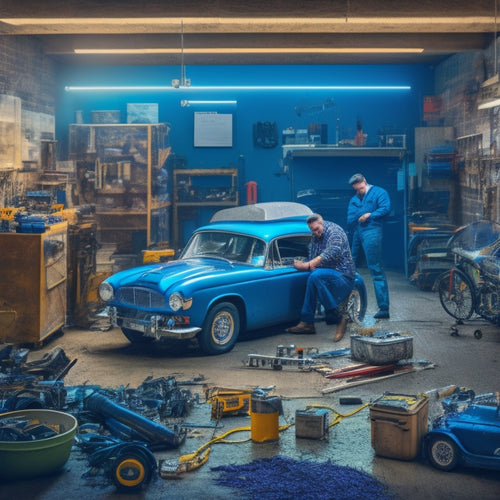
Mastering Energy Monitoring and Automation Made Easy
Share
You're taking control of your energy management system, leveraging advanced monitoring and automation tools to optimize energy efficiency, reduce costs, and maximize sustainability in your buildings and solar panel investments. You're implementing real-time monitoring systems to track energy consumption, identifying areas for improvement, and automating energy-saving measures. With seamless integration of devices and systems, you're streamlining energy management and optimizing solar panel performance. As you master energy monitoring and automation, you'll uncover even more opportunities to refine your strategy and make data-driven decisions that drive results.
Key Takeaways
• Implement real-time energy monitoring systems to track performance, identify losses, and optimize efficiency for maximum returns on solar investments.
• Integrate automated controls to minimize energy consumption, regulate lighting, heating, and cooling systems, and enhance sustainability in smart buildings.
• Utilize advanced analytics and predictive models to detect anomalies, optimize energy consumption patterns, and enable accurate forecasting for proactive decision-making.
• Leverage real-time visualization tools to provide clear insights into energy usage, identify trends and patterns, and facilitate prompt response to changes in energy consumption.
• Establish modular workflows with conditional logic and real-time feedback loops to streamline energy-saving initiatives, optimize resource allocation, and improve system architecture.
Simplifying Solar Energy Tracking
By integrating a monitoring system that tracks your solar panel's performance in real-time, you can pinpoint energy losses and optimize your system's overall efficiency. This advanced monitoring capability guarantees you're getting the most out of your solar investment, enabling you to capitalize on valuable Solar Incentives.
With precise monitoring, you'll identify areas for improvement, maximizing your energy harvest and reducing waste. Moreover, this real-time data facilitates informed decisions about Energy Storage solutions, making sure you're equipped to store excess energy for later use.
By streamlining your solar energy tracking, you'll discover new opportunities for energy independence and cost savings. With a clear understanding of your energy production and consumption patterns, you'll be empowered to make data-driven decisions that drive results.
Real-Time Energy Consumption Insights
As you explore real-time energy consumption insights, you'll gain a deeper understanding of your energy usage patterns.
You'll have access to live consumption data, allowing you to pinpoint areas of inefficiency and identify opportunities for optimization.
Energy Usage Patterns
Your real-time energy consumption insights rely heavily on accurate energy usage patterns, which involve tracking and analyzing your energy consumption habits to identify areas of inefficiency. By understanding your energy usage patterns, you can pinpoint opportunities to optimize energy consumption and reduce waste.
Energy profiling plays a vital role in this process, as it involves creating a detailed profile of your energy consumption habits over time. This profile is then used to identify patterns and anomalies, enabling you to make data-driven decisions about energy efficiency.
Pattern recognition is an essential aspect of energy profiling, as it allows you to identify recurring patterns in your energy consumption. For instance, you might notice that your energy consumption peaks during certain times of the day or week. By recognizing these patterns, you can adjust your energy usage habits accordingly, implementing strategies to reduce consumption during peak periods.
Live Consumption Data
With a deeper understanding of your energy usage patterns, you can now leverage live consumption data to gain real-time insights into your energy consumption, enabling you to respond promptly to inefficiencies and optimize energy usage on the fly.
As you tap into live consumption data, you'll discover opportunities to reduce energy waste and access cost savings. By monitoring your energy usage in real-time, you can identify areas of inefficiency and take corrective action to minimize your energy footprint. This level of granular visibility empowers you to make data-driven decisions, fine-tuning your energy strategy to maximize efficiency and minimize waste.
Data visualization tools make it easy to digest complex energy consumption data, providing a clear and concise snapshot of your energy usage. With this information at your fingertips, you can pinpoint areas of improvement, optimize your energy strategy, and reap the benefits of reduced energy costs.
Automating Energy Efficiency Controls
By integrating automated energy efficiency controls into your building management system, you can optimize energy usage and reduce waste. This is particularly vital in smart buildings, where energy audits have become an essential aspect of maintaining a sustainable and eco-friendly environment.
By automating energy efficiency controls, you can identify areas of inefficiency and take corrective action to minimize energy consumption. You can set up automated controls to regulate lighting, heating, and cooling systems, ensuring that energy is used only when needed.
For instance, you can program your lighting system to turn off when natural light is sufficient or when a room is unoccupied. Similarly, you can automate your HVAC system to adjust temperature settings based on occupancy schedules and outdoor weather conditions.
Optimizing Solar Panel Performance
As you aim to optimize your solar panel performance, you'll need to analyze the efficiency of your panels to identify areas for improvement.
You'll want to examine factors such as panel temperature, irradiance, and shading to determine how they impact energy output.
Panel Efficiency Analysis
You can increase your solar panel system's overall energy yield by up to 15% through meticulous panel efficiency analysis. This involves identifying and addressing performance bottlenecks, guaranteeing that your system operates at its peak potential, generating more power and reducing energy losses.
To achieve this, you'll need to conduct regular panel maintenance, which includes cleaning, inspecting, and repairing or replacing damaged panels. Thermal imaging is an essential tool in this process, as it helps detect temperature anomalies that can indicate malfunctioning panels. By identifying and addressing these issues promptly, you can prevent energy losses and optimize your system's performance.
Additionally, thermal imaging enables you to pinpoint specific areas where energy is being wasted, allowing you to take targeted corrective action. By incorporating panel efficiency analysis into your energy monitoring and automation strategy, you'll be able to maximize your solar panel system's energy yield, reduce energy waste, and reap the financial benefits of peak performance.
Energy Harvesting Strategies
Maximizing solar panel performance relies on implementing effective energy harvesting strategies that maximize energy output, and one key approach is to ensure the optimal panel orientation and tilt to capture the most sunlight throughout the day.
By optimizing panel placement, you can increase energy production by up to 40%.
Another vital strategy is to minimize thermal losses by using thermal conversion techniques, such as heat sinks or cooling systems, to reduce panel temperatures and boost efficiency.
Additionally, you can draw inspiration from bio-inspired systems, like leaves or trees, to develop more efficient solar panel designs that mimic nature's ability to harness sunlight.
For instance, you can design panels with built-in concentrators or trackers that adjust to the sun's movement, increasing energy output.
By combining these approaches, you can greatly enhance your solar panel's performance, reducing energy waste and increasing your overall energy independence.
Energy Monitoring System Integration
Your energy monitoring system integration requires vital communication between various devices and systems to provide a thorough view of your energy usage. This integration is essential to optimize energy efficiency, reduce costs, and minimize environmental impact.
To achieve this, you'll need to focus on system design and network architecture. In system design, you'll need to take into account the type of devices and systems you're integrating, such as meters, sensors, and building management systems (BMS). You'll also need to determine the communication protocols and data formats used by each device. This information will help you design a system that can collect, transmit, and analyze energy usage data efficiently.
Your network architecture should be designed to support the communication requirements of your devices and systems. This includes deciding on the network topology, such as a star or mesh network, and choosing the right communication protocols, such as Modbus or BACnet.
Advanced Data Analytics Capabilities
Advanced data analytics capabilities enable the extraction of valuable insights from the vast amounts of energy usage data collected. This allows for more accurate forecasting, anomaly detection, and optimization of energy consumption patterns. You'll be able to reveal areas of inefficiency and opportunities for improvement, making data-driven decisions to reduce energy waste and costs.
With advanced analytics, you can develop predictive models that forecast energy consumption patterns, enabling you to proactively manage energy resources and optimize your energy strategy. Real-time visualization tools provide a clear and intuitive view of your energy usage, allowing you to quickly identify trends, patterns, and anomalies. This enables you to respond promptly to changes in energy consumption, ensuring that your energy management strategy remains effective and efficient.
Seamless Automation Workflows Design
By integrating automation workflows into your energy management system, you can streamline energy-saving initiatives and optimize resource allocation, freeing up personnel to focus on higher-value tasks. This seamless automation workflow design enables you to create a more efficient system architecture, where data-driven insights inform improved workflows.
To achieve this, consider the following key aspects of workflow optimization:
-
Modular Design: Break down complex workflows into smaller, manageable modules, allowing for easier maintenance and updates.
-
Conditional Logic: Implement if-then statements to automate decision-making processes, reducing manual intervention and increasing efficiency.
-
Real-time Feedback Loops: Establish continuous feedback mechanisms to monitor and adjust workflows in real-time, ensuring peak performance and energy savings.
Frequently Asked Questions
Can Energy Monitoring Systems Be Integrated With Existing Building Management Systems?
You can seamlessly integrate energy monitoring systems with existing building management systems, enabling efficient system integration and data exchange, allowing you to leverage real-time insights and optimize energy consumption.
How Often Should Energy Consumption Data Be Updated for Accurate Insights?
For accurate insights, you'll want to make sure your energy consumption data is updated frequently. Aim for real-time updates, ideally every 15-30 minutes, to maintain data freshness and make informed decisions about your energy usage.
Are Energy Monitoring Systems Compatible With Various Types of Solar Panels?
You'll be glad to know that most energy monitoring systems are compatible with various solar panel types, considering factors like panel efficiency and inverter compatibility, ensuring seamless integration for peak performance tracking.
Can Energy Automation Controls Be Customized for Specific Building Types?
"As you explore energy automation, you'll find that controls can be customized for specific building types, adhering to local Building Codes and incorporating Zone Segregation, ensuring a tailored approach that suits your unique needs."
What Level of Technical Expertise Is Required to Set up Energy Monitoring Systems?
When setting up energy monitoring systems, you'll need basic technical knowledge, but DIY installation is possible with user-friendly interfaces; however, expert consulting guarantees the best customization, so consider seeking professional guidance for a tailored solution.
Related Posts
-

Why You Need a Phone Mount for Navigation
When you're on the road, a reliable phone mount is not just a convenience, it's a safety necessity that helps you mai...
-

5 Essential Tips for Buying EV Charging Systems Online
When purchasing an EV charging system online, you'll want to make sure you're making an informed decision. First, det...
-

Step-by-Step Guide to Converting Your Vehicle to EV
You'll begin by evaluating your vehicle's conversion potential, analyzing its weight, aerodynamics, and powertrain co...


